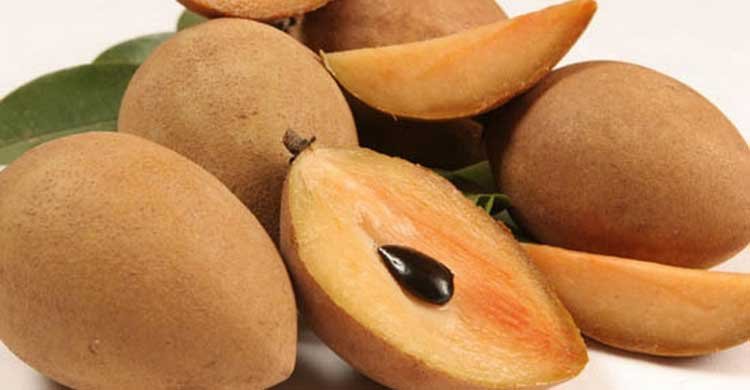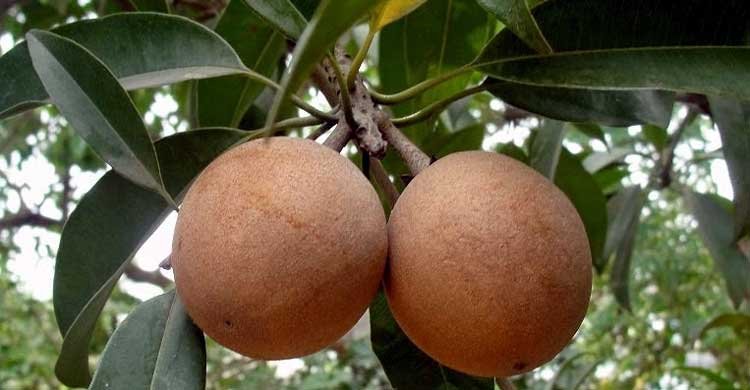Sofa

Photo source
Saphada or 'Sabbeda' ( English : Sapodilla ; Scientific name : Manilkara zapota ) The sapda tree is a perpetual tree, evergreen tree; Its local home is situated in the southern piece of Mexico, Central America and the Caribbean. The tree normally developed in waterfront Yucatán in the Pettens mangrove eco-locale. It was taken in the Philippines amid the Spanish pilgrim time. It is generally created in Bangladesh, India , Pakistan and Mexico .
Description:

Photo source
The couch can be 30 m (98 ft) taller or significantly more. Its trunk distance across can be up to 1.5m (4.9 ft). In any case, it is generally 9-15 meters (30-49 feet) tall; And its trunk isn't thicker than 50 cm (20 inches) thick. These trees may get by in the tempest twist There are loads of white paste cells in its back, which is known as 'Chain'. As the drain like tubes are exceptionally sticky, it was once considered as one of the fixings in the biting gum industry.Raw gum crude material was set up by the Aztecs progress . Its leaves are wonderful, medium-sized, green and sparkling. These are exchange, curved or oval, 7-15 cm Is tall.Its blooms are white, bellied, with six split petals.
Saphida organic product is a major curved 'berry' national. Its breadth is 4-8 cm. It would appear that a smooth potato. There are 2-5 seeds inside it. The internal head is dark colored in shading from light to yellow. Seed dark The aftereffect of the sapheda is extremely solid. It can not be effectively expelled from the tree. In the event that you keep them in the house, they are delicate and consumable.
The couch is quite sweet. Crude natural products are solid and 'saponin' rich. The saphida tree does not live without warm and tropical districts. Effectively kick the bucket in cool climate . It takes 5-8 years to create organic product on the couch tree. It might bring about two times per year regardless of whether the tree has a few blossoms consistently.
Other names:

Photo source
In the Virgin Islands, saphida is called 'mípsel', Honduras , El-Salvador, and Cuba, 'zapote', Dominican Republic, Costa Rica, Cuba, Puerto Rico, Nicaragua, Colombia and Venezuela, 'níspero', Bahamai Its name is 'dilly', Jamaica and other Caribbean districts called 'naseberry', in Brazil and Haiti 'sapoti', the name of 'chico' or 'tsiko' in the Philippines and Mexico, Hawaii, South California and Dak In Florida it is called 'chicosapote' or 'chicozapote'.
In India its name is 'Chiku' or 'Chikku' ("Chikku" or chiku , "Chaku,"). In Pakistan, its name is 'Chiku' or 'Alucha' ("چیکو" chiku or "آلوچہ" âlucha ). In different parts of India, for example, Tamilnadu, Kerala, Karnataka, Andhra Pradesh and so on it is called sapota . The name of 'sapathilla' or 'rata-mi' in Sri Lanka In Bangladesh and East India its name is 'sobeda/sofeda' (sabeda or couch). In Maldives, its name is sabudheli ("ސަބުދެލި"). Its name in Indonesia is 'sawo'. In West Sumataya it signifies 'saos'. Viet Nam's name is hồng xiêm (lit. Siamese persimmon), lồng mứt or xa pô chê . In addition, it is called lamoot (ละมุด) in Thailand, Laos and Cambodia.
Its name is ciku in standard Malay dialect And the name of the Selpan dialect in Kelantan Malay In China, numerous individuals commit errors by deciphering it as 'Jingsheng Fal' (人參 果). Despite the fact that its genuine Chinese name is "heart organic product" (人心 果).